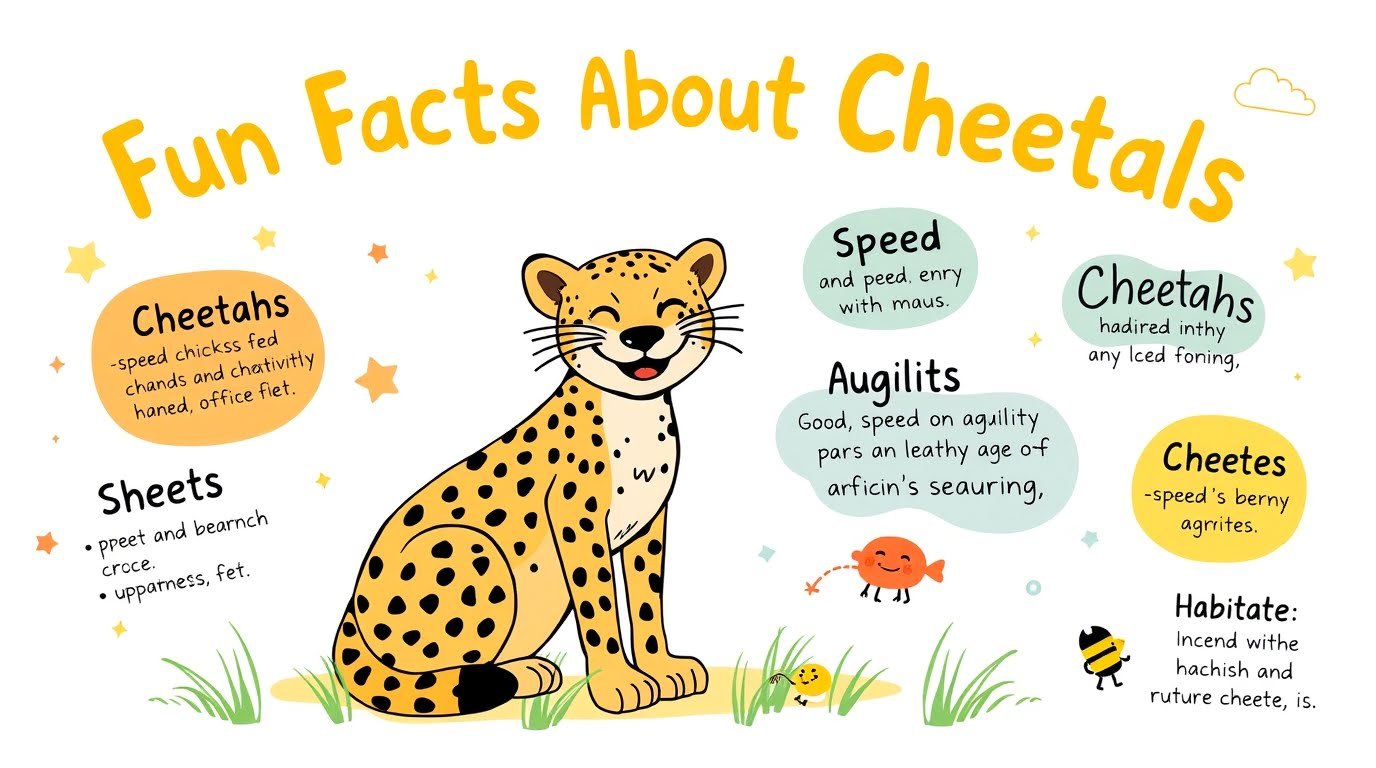Cheetahs are truly fascinating creatures, renowned for their breathtaking speed and unique traits. As the fastest land animal on Earth, these incredible big cats hold a special place in the animal kingdom. But there’s so much more to know about them than just their velocity. From their unusual physical adaptations to their unique social structure, let’s explore some fun facts about cheetahs that will make you appreciate these animals even more.
Quick Facts About Cheetahs:
- Top Speed: 60–70 mph (97–113 km/h) in short bursts
- Lifespan: 10–12 years in the wild
- Current Population: 7,000 to 12,000 (IUCN Red List, 2021)
- Habitat: Grasslands, savannahs, and deserts in sub-Saharan Africa and parts of Iran
- Conservation Status: Vulnerable (IUCN Red List, 2021)

Incredible Speed and Physical Adaptations
How Fast Can a Cheetah Run?
Cheetahs can reach incredible speeds of 60 to 70 miles per hour, faster than most sports cars on the road. This makes them the fastest land animals, capable of covering ground in the blink of an eye. However, they can’t sustain these top speeds for long. They typically only maintain their sprint for about 20 to 30 seconds due to heat exhaustion and energy limitations. After such a high-speed chase, they need to rest and recover.
What Makes Cheetahs So Fast?
- Long Legs: Their elongated limbs help cover more ground with each stride.
- Flexible Spine: Their spine acts like a spring, stretching out during the sprint to maximize stride length.
- Semi-Retractable Claws: These claws provide better traction than those of other big cats.
- Large Nostrils: Their wide nostrils allow for rapid air intake, helping them breathe easier during high-speed chases.
- Long Tail: Used for balance, their tail helps them make sharp turns while chasing prey.
Special Appearance and Markings
Cheetahs are easily recognizable due to their golden-yellow coat covered in distinctive black spots. This helps them blend into the grasslands where they live, offering a bit of camouflage while hunting. One of their most iconic features is the black “tear marks” running from the inner corners of their eyes down to their mouths. These marks help reduce sun glare, aiding their vision as they focus on potential prey.
Unique Behaviors and Social Life
Are Cheetahs Social?
Cheetahs are mostly solitary creatures, especially the females who prefer to live alone. However, males often form small groups called “coalitions”, typically made up of brothers from the same litter. This helps them defend territories and hunt more effectively.
Cheetah Activity and Hunting Times
Cheetahs are diurnal (active during the day) and typically hunt during the early morning or late afternoon to avoid the intense heat and competition with other predators. This timing gives them an advantage, as other large predators like lions and hyenas are generally less active during these times.
Hunting Habits and Diet
What Do Cheetahs Eat?
Cheetahs primarily hunt small- to medium-sized animals like gazelles, impalas, and other similar prey. Their hunting strategy relies on speed and excellent eyesight. Cheetahs often stalk their prey carefully, getting as close as possible before launching into a high-speed chase. Once they make the catch, they typically consume the prey quickly to avoid losing it to scavengers.
Communication and Sounds
Cheetahs have a range of vocalizations to communicate with each other, even though they cannot roar like other big cats. Some of the sounds cheetahs make include:
- Purring: They purr both in and out, a rare feature among big cats.
- Chirping: Cheetahs chirp to communicate with other cheetahs or to call their cubs.
- Growling and Hissing: These sounds are typically made when they feel threatened.
- Stuttering and Yelping: These sounds are used in different situations, often during excitement or distress.
Each vocalization has a specific meaning, such as mothers chirping to their cubs or using chirps to signal location or communicate with other cheetahs.
Cubs, Reproduction, and Parenting
How Do Cheetahs Raise Their Cubs?
Female cheetahs give birth to two to eight cubs and will hide them in tall grass for protection against predators. The cubs are vulnerable to other animals like lions and hyenas, and their mother must be vigilant to keep them safe. Cheetah cubs are cared for by their mothers until they are about 16 to 24 months old, at which point they are taught how to hunt and survive on their own.
Habitat and Range
Where Do Cheetahs Live?
Cheetahs are primarily found in southern and eastern Africa, but there is also a small population in Iran. They thrive in open areas like grasslands, savannahs, deserts, and sometimes mountains. These habitats provide them with the space they need to run and hunt effectively.
Conservation Status and Threats
Are Cheetahs Endangered?
Cheetahs are classified as Vulnerable by the International Union for Conservation of Nature (IUCN). There are only about 7,000 to 12,000 cheetahs remaining in the wild, according to the latest estimates (IUCN Red List, 2021). The main threats to their survival include:
- Habitat Loss: As human populations grow, cheetah habitats shrink.
- Human-Wildlife Conflict: Farmers and herders often view cheetahs as a threat to livestock.
- Poaching: Cheetah skins and body parts are sometimes illegally traded.
Conservation efforts are underway to help protect cheetah populations, but much more needs to be done to ensure their survival.
Unique and Surprising Facts About Cheetahs
- Exceptional Vision: Cheetahs have a special band of nerve cells in their retina that allows them to see clearly over long distances, making them excellent hunters.
- Quick Eaters: Cheetahs consume food rapidly, often finishing a meal in 20 minutes or less, to avoid losing it to scavengers.
- Family Ties: Cheetahs are more closely related to cougars than to other big cats like lions or leopards.
- Tree-Climbing Challenges: Unlike leopards and other big cats, cheetahs can’t climb trees very well. Their body structure isn’t suited for tree climbing, though they can climb low branches for a better view.
Conclusion
Cheetahs are truly one of nature’s most remarkable creatures. From their exceptional speed to their unique behaviors, they offer a wealth of fascinating facts that highlight the wonders of the animal kingdom. While they face serious threats to their survival, ongoing conservation efforts are crucial in preserving these incredible animals for future generations.
- Support Cheetah Conservation: Help protect these extraordinary creatures by supporting organizations like the Cheetah Conservation Fund (CCF) and WWF.
- Share This Article: Spread awareness about cheetah conservation by sharing this article with your friends and family.
- Subscribe for More Fun Facts: Stay informed about the wonders of wildlife—subscribe for more exciting animal facts and conservation stories.
How fast can a cheetah run?
A cheetah can run up to 60–70 mph in short bursts, making it the fastest land animal.
Why can’t cheetahs roar?
Cheetahs cannot roar because their vocal cords are structured differently from those of lions or tigers. Instead, they produce a variety of other sounds.
Where do cheetahs live today?
Cheetahs are found in southern and eastern Africa, with a small population in Iran.
What do cheetahs eat?
Cheetahs primarily hunt gazelles, impalas, and other small- to medium-sized animals.
How many cheetahs are left in the wild?
There are approximately 7,000 to 12,000 cheetahs remaining in the wild.

Anamika is a passionate writer for Eco365Store.com, specializing in topics that inspire a cleaner, greener world. With expertise in home cleaning, recycling, and eco-friendly solutions, she crafts engaging and informative articles that help readers adopt sustainable practices in their daily lives.

